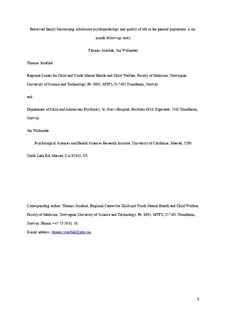Perceived family functioning, adolescent psychopathology and quality of life in the general population: a 6-month follow-up study
Journal article, Peer reviewed
Accepted version

Åpne
Permanent lenke
http://hdl.handle.net/11250/2599480Utgivelsesdato
2015Metadata
Vis full innførselSamlinger
- Institutt for psykisk helse [1197]
- Publikasjoner fra CRIStin - NTNU [37215]
- St. Olavs hospital [2441]
Originalversjon
Quality of Life Research. 2015, Published ahead of print 1-9. 10.1007/s11136-015-1138-9Sammendrag
Purpose
The aim of the study was to investigate whether perceived family functioning of adolescent is moderating or mediating the longitudinal association of adolescent internalizing and externalizing psychopathology with quality of life (QoL) after 6 months in the general population.
Methods
Using a cluster sampling technique in one Norwegian county 1331, 10- to 16-year-old students were included in the study (51 % girls). Parents completed the Child Behavior Checklist for the assessment of adolescent psychopathology at Time 1. The students completed the General Functioning Scale of the McMaster Family Assessment Device and the Inventory of Life Quality in Children and Adolescents at time 2 6 months later. Psychopathology, family functioning and QoL were treated as latent variables in a structural equation model adjusted for sex, age and parent education.
Results
The regression coefficients for paths from psychopathology decreased (β = .199 for the internalizing and β = .102 for the externalizing model) in each case when including the indirect path via family functioning compared with the direct path from psychopathology to QoL. The sum of indirect effects on QoL via family functioning was significant for internalizing β = 0.093 (95 % CI 0.054–0.133) and externalizing β = 0.119 (95 % CI 0.076–0.162) psychopathology.
Conclusions
Family functioning significantly mediated the longitudinal association between psychopathology and QoL. Because the family remains an important social domain for adolescents, it must be an important consideration when attempting to reduce or alleviate psychopathology in youth and improve the quality of their life experience throughout this period.